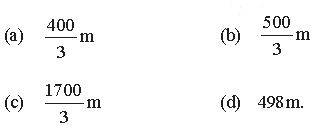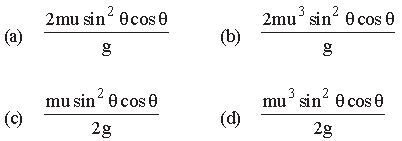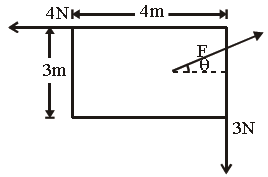Please refer to MCQ Questions Chapter 4 Motion in a Plane Class 11 Physics with answers provided below. These multiple-choice questions have been developed based on the latest NCERT book for class 11 Physics issued for the current academic year. We have provided MCQ Questions for Class 11 Physics for all chapters on our website. Students should learn the objective based questions for Chapter 4 Motion in a Plane in Class 11 Physics provided below to get more marks in exams.
Chapter 4 Motion in a Plane MCQ Questions
Please refer to the following Chapter 4 Motion in a Plane MCQ Questions Class 11 Physics with solutions for all important topics in the chapter.
MCQ Questions Answers for Chapter 4 Motion in a Plane Class 11 Physics
Question . It is found that │A+ B│ =│A│. This necessarily implies,
(a) B = 0
(b) A, B are antiparallel
(c) A, B are perpendicular
(d) A.B < 0
Answer
B
Question . A bucket, full of water is revolved in a vertical circle of radius 2 m. What should be the maximum time-period of revolution so that the water doesn’t fall out of the bucket?
(a) 1 sec
(b) 2 sec
(c) 3 sec
(d) 4 sec
Answer
C
Question . If the sum of two unit vectors is a unit vector, then the magnitude of their difference is
(a) 3
(b) 2
(c) 5
(d) 1/2
Answer
A
Question . Which one of the following statements is true?
(a) A scalar quantity is the one that is conserved in a process.
(b) A scalar quantity is the one that can never take negative values.
(c) A scalar quantity is the one that does not vary from one point to another in space.
(d) A scalar quantity has the same value for observers with different orientations of the axes.
Answer
D
Question . Given that A + B = R and A2 + B2 = R2. The angle between A and B is
(a) 0
(b) π/4
(c) π/2
(d) π
Answer
C
Question . Given that A + B = R and A = B = R. What should be the angle between A and B ?
(a) 0
(b) π/3
(c) 2π/3
(d) π
Answer
C
Question . Two balls are projected at an angle q and (90º – θ) to the horizontal with the same speed. The ratio of their maximum vertical heights is
(a) 1 : 1
(b) tanθ : 1
(c) 1 : tanθ
(d) tan2θ : 1
Answer
D
Question . Three vectors A, B and C satisfy the relation A · B = 0 and A · C = 0. The vector A is parallel to
(a) B
(b) C
(c) B · C
(d) B × C
Answer
D
Question . A projectile thrown with a speed v at an angle q has a range R on the surface of earth. For same v and q, its range on the surface of moon will be

(a) R/6
(b) R
(c) 6 R
(d) 36 R
Answer
C
Question . Let A = iA cos θ + jA sin q be any vector. Another vector B, which is normal to A can be expressed as
(a) i B cos θ – j B sin θ
(b) i B cos θ + j B sin θ
(c) i B sin θ – j B cos θ
(d) i B sin θ + j B cos θ
Answer
C
Question . The greatest height to which a man can through a ball is h. What is the greatest horizontal distance to which he can throw the ball?
(a) 2h
(b) h/4
(c) h/2
(d) None of these
Answer
A
Question . If A and B are two vectors, then the correct statement is
(a) A + B = B + A
(b) A – B = B – A
(c) A × B = B × A
(d) None of these
Answer
A
Question . Three particles A, B and C are projected from the same point with same initial speeds making angles 30º, 45º and 60º respectively with the horizontal. Which of the following statements is correct?
(a) A, B and C have unequal ranges
(b) Ranges of A and C are equal and less than that of B
(c) Ranges of A and C are equal and greater than that of B
(d) A, B and C have equal ranges
Answer
C
Question . A projectile thrown with velocity v making angle θ with vertical gains maximum height H in the time for which the projectile remains in air, the time period is

Answer
D
Question . If ˆn is a unit vector in the direction of the vector A, then

Answer
A
Question . Three particles A, B and C are thrown from the top of a tower with the same speed. A is thrown up, B is thrown down and C is horizontally. They hit the ground with speeds vA, vB and vC respectively then,
(a) vA = vB = vC
(b) vA = vB > vC
(c) vB > vC > vA
(d) vA > vB = vC
Answer
A
Question . Two particles of equal masses are revolving in circular paths of radii r1 and r2 respectively with the same period. The ratio of their centripetal force is
(a) r1/r2
(b) √r2 / r1
(c) (r1/r2)2
(d) (r2/r1)2
Answer
A
Question . A bomb is dropped from an aeroplane moving horizontally at constant speed. If air resistance is taken into consideration, then the bomb
(a) falls on earth exactly below the aeroplane
(b) falls on the earth exactly behind the aeroplane
(c) falls on the earths ahead of the aeroplane
(d) flies with the aeroplane
Answer
B
Question . The range of a projectile when launched at an angle of 15º with the horizontal is 1.5 km. What is the range of the projectile when launched at an angle of 45º to the horizontal
(a) 1.5 km
(b) 3.0 km
(c) 6.3 km
(d) 0.75 km
Answer
B
Question . A gun fires two bullets at 60º and 30º with horizontal. The bullets strike at some horizontal distance. The ratio of maximum height for the two bullets is in the ratio
(a) 2 : 1
(b) 3 : 1
(c) 4 : 1
(d) 1 : 1
Answer
B
Question . A cannon on a level plane is aimed at an angle θ above the horizontal and a shell is fired with a muzzle velocity n0 towards a vertical cliff a distance D away. Then the height from the bottom at which the shell strikes the side walls of the cliff is

Answer
C
Question . An aeroplane flying at a constant speed releases a bomb. As the bomb moves away from the aeroplane, it will
(a) always be vertically below the aeroplane only if the aeroplane was flying horizontally
(b) always be vertically below the aeroplane only if the aeroplane was flying at an angle of 45° to the horizontal
(c) always be vertically below the aeroplane
(d) gradually fall behind the aeroplane if the aeroplane was flying horizontally.
Answer
C
Question . A bomb is released from a horizontal flying aeroplane. The trajectory of bomb is
(a) a parabola
(b) a straight line
(c) a circle
(d) a hyperbola
Answer
A
Question . Two vectors A and B lie in a plane, another vector C lies outside this plane, then the resultant of these three vectors i.e., A + B + C
(a) can be zero
(b) cannot be zero
(c) lies in the plane containing A + B
(d) lies in the plane containing A – B
Answer
B
Question . A projectile can have the same range for two angles of projection. If h1 and h2 are maximum heights when the range in the two cases is R, then the relation between R, h1 and h2 is

Answer
A
Question . In uniform circular motion, the velocity vector and acceleration vector are
(a) perpendicular to each other
(b) same direction
(c) opposite direction
(d) not related to each other
Answer
A
Question . A projectile is projected with a kinetic energy E. Its range is R. It will have the minimum kinetic energy, after covering a horizontal distance equal to
(a) 0.25 R
(b) 0.5 R
(c) 0.75 R
(d) R
Answer
B
Question . The angular speed of a fly-wheel making 120 revolutions/minute is
(a) π rad/sec
(b) 4π rad/sec
(c) 2π rad/sec
(d) 4π2 rad/sec
Answer
B
Question . If range is double the maximum height of a projectile, then q is
(a) tan–14
(b) tan–1 1/4
(c) tan–1 1
(d) tan–1 2
Answer
D
Question . The time of flight of a projectile on an upward inclined plane depends upon
(a) angle of inclination of the plane
(b) angle of projection
(c) the value of acceleration due to gravity
(d) all of the above.
Answer
D
Question . At the highest point on the trajectory of a projectile, its
(a) potential energy is minimum
(b) kinetic energy is maximum
(c) total energy is maximum
(d) kinetic energy is minimum.
Answer
D
Question . From a point on the ground at a distance 2 meters from the foot of a vertical wall, a ball is thrown at an angle of 45º which just clears the top of the wall and afterward strikes the ground at a distance 4 m on the other side. The height of the wall is
(a) 2/3m
(b) 3/4m
(c) 1/3m
(d) 4/3m
Answer
D
Question . Consider two vectors F→1 = 2i + 5k and F→2 = 3j + 4k. magnitude of the scalar product of these vectors is
(a) 20
(b) 23
(c) 5√ 33
(d) 26
Answer
B
Question . Forces of 4 N and 5 N are applied at origin along X-axis and Y-axis respectively. The resultant force will be

Answer
C
Question . A bomb is dropped on an enemy post by an aeroplane flying horizontally with a velocity of 60 km h–1 and at a height of 490 m. At the time of dropping the bomb, how far the aeroplane should be from the enemy post so that the bomb may directly hit the target ?

Answer
B
Question . A ball is projected at such an angle that the horizontal range is three times the maximum height. The angle of projection of the ball is

Answer
D
Question . A projectile of mass m is fired with velocity u making angle q with the horizontal. Its angular momentum about the point of projection when it hits the ground is given by

Answer
B
Question . A rectangular sheet of material has a width of 3 m and a length of 4 m. Forces with magnitudes of 3 N and 4N. respectively, are applied parallel to two edges of the sheet, as shown in the figure below

Question . A third force F, is applied to the centre of the sheet, along a line in the plane of the sheet, at an angle θ= tan 0.75 with respect to the horizontal direction. The sheet will be in translational equilibrium when F has what value?
(a) F = 3 N
(b) F = 4N
(c) F = 5 N
(d) F = 7N
Answer
C
Question . The velocity of projection of a body is increased by 2%. Other factors remaining unchanged, what will be the percentage change in the maximum height attained?
(a) 1%
(b) 2 %
(c) 4 %
(d) 8 %
Answer
C
Question . A body is projected such that its KE at the top is 3/4th of its initial KE. What is the angle of projectile with the horizontal?
(a) 30º
(b) 60º
(c) 45º
(d) 120º
Answer
A
Question . The magnitude of the vector product of two vectors is √3 times the scalar product. The angle between vectors is
(a) π/4
(b) π/6
(c) π/3
(d) π/2
Answer
C
Question . If A = B + C and the magnitudes of A, B and C are 5, 4 and 3 units, the angle between A and C is
(a) cos–1 (3/5)
(b) cos–1 (4/5)
(c) π/2
(d) sin–1 (3/4)
Answer
A
Question . Consider a vector F = 4 i – 3 j. Another vector that is perpendicular to F is
(a) 4 i + 3 j
(b) 6 i
(c) 7 k
(d) 3 i – 4 j
Answer
C
Question . A ball is thrown from the ground with a velocity of 20√3 m/s making an angle of 60º with the horizontal. The ball will be at a height of 40 m from the ground after a time t equal to (g = 10 ms–2)
(a) √2 sec
(b) √3 sec
(c) 2 sec
(d) 3 sec
Answer
C
Question . A particle moves in a circle of radius 25 cm at two revolutions per second. The acceleration of the particle in meter per second2 is
(a) π2
(b) 8 π2
(c) 4 π2
(d) 2 π2
Answer
C
Question . The vector sum of the forces of 10 N and 6 N can be
(a) 2 N
(b) 8 N
(c) 18 N
(d) 20 N
Answer
B
Question . A projectile is thrown horizontally with a speed of 20 ms–1. If g is 10 ms–2, then the speed of the projectile after 5 second will be nearly
(a) 0.5 ms–1
(b) 5 ms–1
(c) 54 ms–1
(d) 500 ms–1
Answer
C
Question . A body is projected horizontally from a point above the ground and motion of the body is described by the equation x = 2t, y = 5t2 where x, and y are horizontal and vertical coordinates in metre after time t. The initial velocity of the body will be
(a) √29 m/s horizontal
(b) 5 m/s horizontal
(c) 2 m/s vertical
(d) 2 m/s horizontal
Answer
D
Question . A wheel rotates with constant acceleration of 2.0 rod/s2, if the wheel starts from rest the number of revolutions it makes in the first ten seconds will be approximately
(a) 32
(b) 24
(c) 16
(d) 8
Answer
C
Question . Out of the following sets of forces, the resultant of which cannot be zero ?
(a) 10, 10, 10
(b) 10, 10, 20
(c) 10, 20, 20
(d) 10, 20, 40
Answer
D

We hope you liked the above provided MCQ Questions Chapter 4 Motion in a Plane Class 11 Physics with solutions. If you have any questions please ask us in the comments box below.


